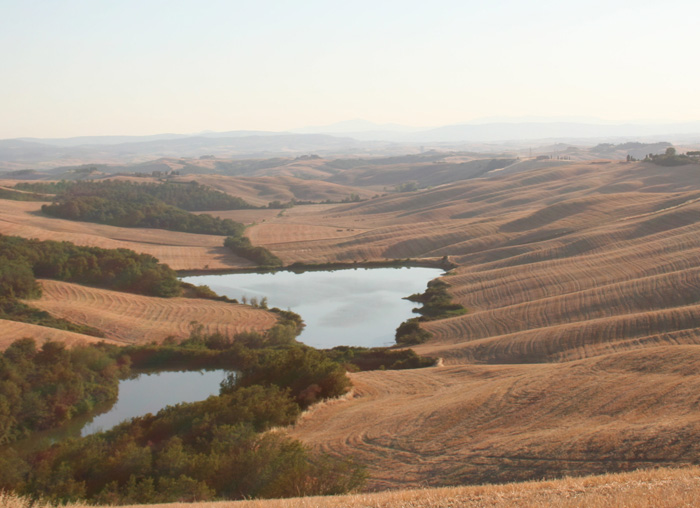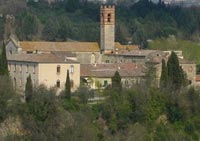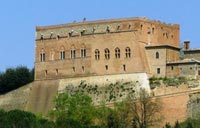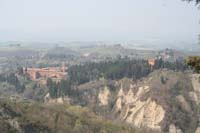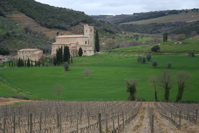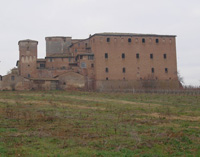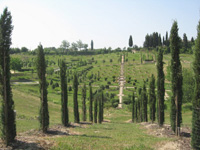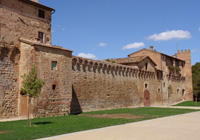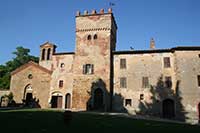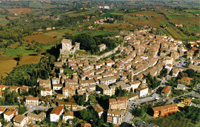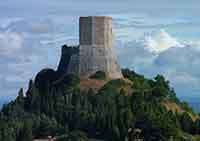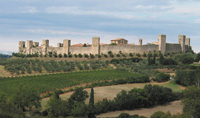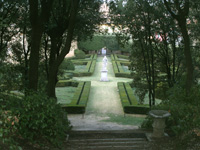Terre di Siena | Breathtaking views on a trip through art and culture |
| The Terre di Siena, as the countryside around Siena is known, are a stunning backdrop to the territory's artistic and cultural wonders, with dozens of roads to follow, each itinerary offering new ways of discovering Siena's natural beauty as you seek out its best known masterpieces. The Crete Senesi is known for its soft hills and many consider it to be the most beautiful part of this region. Driving from Siena to Montalcino, the capital of Brunello wines, the views are unforgettable and stops at the Sacred Art Museum at Asciano and the stunning Abbey of Monteoliveto Maggiore are absolute musts. The Val d'Orcia is the next stop, following the cypresses along a path that cuts the Terre di Siena from west to east and offers a natural panoramic viewpoint over one of Tuscany's most beautiful, and best known, corners. Heading from San Quirico d'Orcia towards Pienza, the "ideal" city born out of Renaissance humanism. Continue along your journey, stopping in Montepulciano for a visit to the cellars under the city and a taste of the local Nobile di Montepulciano, one of Tuscany's most prestigious wines. The Val d'Orcia itinerary continues with a visit to the spas at Chianciano Terme and ends at Chiusi, a fascinating city which hides an Etruscan past in its underground Porsenna Labyrinth. The Val d'Elsa is full of rich green woods and artistic masterpieces and is less visited than the neighbouring Val d'Orcia. Departing from Poggibonsi the first stop on the road is San Gimignano, the city of towers. Casole d'Elsa is the next stopover for a visit to the Collegiata di Santa Maria Assunta and the 14th-century fortress. This itinerary then ends toward Chiusino in the Val di Merse and the evocative Abbey of San Galgano. For another perspective on the Terre di Siena follow the ancient Via Cassia which connected Siena with Rome. The road passes through Buonconvento, then Montalcino and Bagno Vignoni, with its beautiful water piazza and thermal springs. Further west, at the Via Cassia (Via Francigena) road junction, San Quirico d'Orcia (known as Osenna in medieval times) From here continue along to the foothills of the Amiata Mountain and stop at Bagni San Filippo, another thermal village where the waters spring from the earth at temperatures around 50° celsius. |
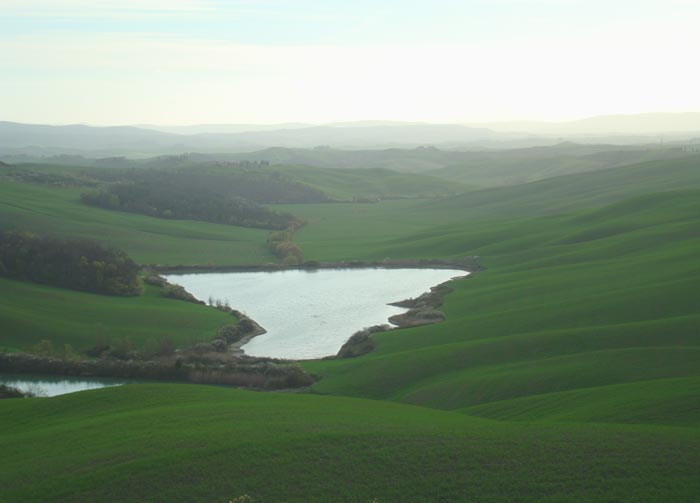 |
|||||
Terre di Siena, April. Morning light on two lakes between Leonina and Vescona, Crete Senesi, Asciano
|
|||||
| You can’t really say what is beautiful about a place, but the image of the place will remain vividly with you. Tadao Ando |
|||||
The Crete Senesi |
|||||
Considered the grain house of Siena for centuries, the lovely landscape of Crete Senesi is dotted with estates where farmers work according to traditional methods. The area’s famed Brunello and the white truffle of San Giovanni d’Asso are both excellent reasons to spend the week-end in this unique setting. The territory’s historical roads (the Laurentana, via di Rapolano and the Monte Sante Marie) lead to the Abbey of Monteoliveto Maggiore—the most important monastery complex of the Sienese territory. Don’t miss an outing to the wonderful thermal baths of Rapolano, or the Bosco della Ragnaia, Sheppard Craige’s open workshop. This American artist, resident of San Giovanni d’Asso, has created a park which will certainly spark a visitor’s curiosity. For a variety of wine tastings, take a trip to the wine cellars recommended by Brunello’s Consortium. |
|||||
| Asciano, just southeast of Siena in the heart of the Crete Senese, is a small rural hamlet in the beautiful Tuscan hills. The town was originally built in its current form during the medieval period, but ancient settlements by the Etruscans and Romans provide the area with an even richer and more diverse cultural heritage. The main attraction is the Duomo, a beautiful 12th century cathedral which houses some great examples of Gothic architecture inside as well as the Museo dell’Opera del Duomo which features many works by Sienese master painters. Other points of interest around the town include the Piazza del Campo, the Torre del Mangia and the botanical gardens. Art lovers will also enjoy a trip to the Museo d’Arte Sacra, which holds numerous works by 13th and 14th century artists. One of Asciano’s neighbouring communes which is also definitely worth a day trip to is San Giovanni d’Asso, which is dominated by the magnificent castle. The castle is also home to the tartufo museum. |
|||||
Two winding roads among the vineyards of Montalcino will take visitors to Torrenieri, Sant’Angelo in Colle and Poggio alle Mura. From Castelnuovo dell’Abate, you can easily reach the Abbey of Sant’Antimo, one of Italy ’s most famous Romanesque works. Abbazia di Sant' Antimo is an active monastic church dating from 1118 and located just a few kilometers from Montalcino. Abbadia a Sicille is an old village in the hills around Siena, one of the richest historical and artistic regions, on the ridge that separes the Chiana and the Orcia valleys. Abbadia a Sicille was built by the Templars as a hospice on the pilgrim road to Rome.
|
|||||
|
|||||
| The Val d'Orcia extends from the hills south of Siena to Monte Amiata. It is characterised by gentle, carefully-cultivated hills occasionally broken by gullies and by picturesque towns and villages such as Pienza (rebuilt as an ideal town in the 15th century under the patronage of Pope Pius II), Radicofani and Montalcino. The Val d'Orcia, this fascinating oasis of nature and culture, is set among acres of olive groves, oak forests and vineyards. The river that gave its name to the valley is little more than a creek for the better part of the year. Prone to dry up in the summer heat, it becomes, come fall, an impetuous river capable of sweeping away anything it finds in its path. The river finds its source in the hills between Radicofani and Sarteano and then it flows into a wide cultivated valley. As it bends eastward, it touches the hillsides of Pienza, San Quirico, Montalcino and Castiglione d'Orcia. It follows the Amiata and curves around the hills of the high Maremma, before flowing into the Ombrone. | |||||
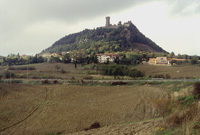 |
|||||
| The river’s water comes from the Orcia River and its tributaries, but it also receives currents from Bagno Vignoni and Bagni San Filippo. These thermal waters, which rise from the heart of the volcano, have offered well-being and health remedies for thousands of years. Castiglione d’Orcia marks the boundary between the Val d’Orcia and the forests of Monte Amiata. San Quirico Val d'Orcia lies on the northern edge of the Val d'Orcia in a strategic position along the Via Cassia and the Via Francigena. In the district of Rocca d’Orcia, one will find the churches of Pieve di San Simeone (XIII century), Compagnia di San Sebastiano and Madonna del Palazzo. The later has been desecrated and recently transformed into a residential building. Visitors won’t be able to resist a stop at Vivo d’Orcia, a tourist hot-spot at the foot of the Amiata. Not far from the center, you’ll find the ‘Eremo del Vivo’ a late Renaissance structure designed by Antonio da San Gallo, ‘Il giovane.’ A short walk from Vivo’s aqueduct will take you to the little church of ‘Ermicciolo’ and the famous ‘Seccatoi’ area, which many expects consider the town’s first ancient settlement. Make sure to visit the historical center of Campiglia d’Orcia—a charming town which has maintained its Medieval characteristics. Near the hamlet, one can find the remains of the Campigliola tower. |
|||||
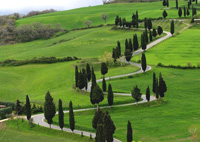 |
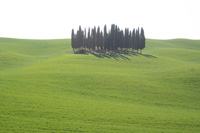 |
||||
The Val d’Elsa |
|||||
| The Val d’Elsa lies between the provinces of Florence and Siena. Divided by the river Elsa, this area of Tuscany is one of the region’s most beautiful sections of countryside. As well as boasting a vast historical and artistic heritage made up of chapels, churches, ancient monuments and magnificent 15th and 16th century villas such as Collazzi and Tattoli, the Val d’Elsa also abounds in excellent restaurants and fine regional cuisine. There are many lovely hill villages in Tuscany but San Gimignano attracts most of the tourist traffic. In order to spread this largesse around a collective of six villages has been formed. They include San Gimignano and all are in the area of Val d'Elsa. The others are Poggibonsi, Colle Val d’Elsa, Monteriggioni, Radicondoli, and Casole d’Elsa. San Gimignano is a small walled medieval hill town in the province of Siena, Tuscany, north-central Italy. It is mainly famous for its medieval architecture, especially its towers, which may be seen from several kilometers outside the town. Half way between San Gimignano and Pienza, on a hill that overlooks the Via Cassia-Francigena, is Monteriggioni, a magnificent fortified town that has retained its circle of walls almost completely intact. Colle di Val d'Elsa was originally developed as three independent areas: Borgo di Santa Caterina, Castello di Piticciano and Il Piano. Colle di Val d'Elsa has a small but attractive old town with two important provincial museums, the Museum of Civic and Religious Art and the Archaeological Museum, as well as quite a good Museum of Lead-Crystal Glass. In its history, Colle di Val d'Elsa was the setting for frequent military events. Among the most famous of these we would note the battle of 1269 between the Guelfs and Ghibellines, which had significant repercussions for the political geography of Tuscany. In the 17 C, the Usimbardi family introduced glass production into Colle di Val d'Elsa. The paper industry was replaced by the new iron and glass industries. The production of glass evolved into lead-glass crystal production and this became the principal industrial activity of Colle di Val d'Elsa, which became known as the Bohemia of Italy in the 19 C. Today Colle di Val d'Elsa produces 15% of the world's crystal. |
|||||
 |
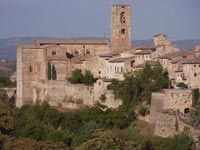 |
||||
Radicondoli is a quiet little place and good local restaurants based on hunting and mushrooming. There are thermal springs all around this area; plumes of steam rise from the foliage in the surrounding hills. Casole d’Elsa is another tiny village, surrounded by the ruins of its mediaeval walls. It has a fine archeological museum containing Etruscan tombs, reliqueries, and an illuminated book of gregorian chants from the 15th-century. |
|||||
| Via Cassia |
|||||
|
On the ancient Via Cassia road, you’ll find Palazzo della Posta, a Medici villa transformed into a hotel that has hosted various renowned visitors. This winding road brings travellers to the medieval hamlet of Contignano. On the south side of the valley, you’ll find San Quirico d’Orcia, which developed alongside the medieval village of Osenna, which became part of Siena ’s settlements in 1256. In the center, surrounded by a series of walls, one can visit the Collegiata dei Santi Quirico e Giulitta, with its magnificent Romanesque-Gothic portals. Don’t miss the church of the Misericordia, Palazzo Pretorio, Palazzo Chigi and Santa Maria di Vitaleta. Nature lovers will enjoy the area’s Horti Leonini, noteworthy Italian gardens that were created in 1540 by Diomede Leoni. Said gardens currently host contemporary sculpture. The church of Santa Maria Assunta, the Giardino delle Rose, rose garden and the ancient hospital, Ospedale della Scala complete the tour. If you follow the Cassia southwards, you’ll arrive at Bagno Vignoni, the thermal station that has been known since Medieval times for its celebrated piazza d’acqua. On the slope that leads towards the river, you’ll find the Parco dei Mulini — interesting park that bears witness to plumbing constructions and techniques that were invented in medieval times. |
|||||
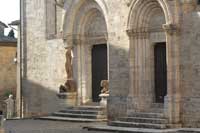 |
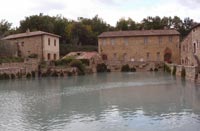 |
||||
|
|||||
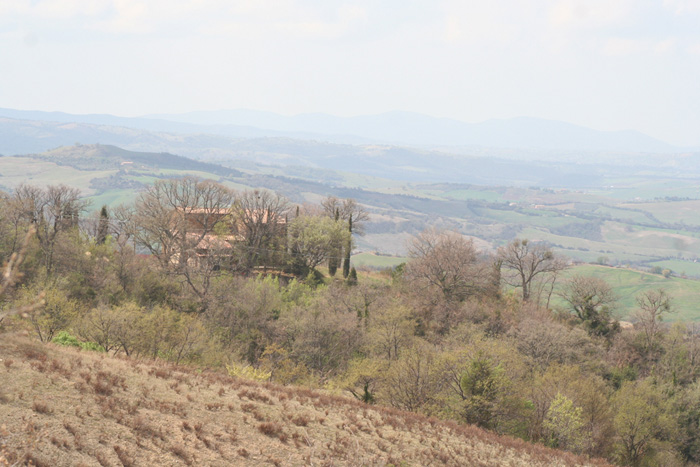 |
|
Podere Santa Pia, April |
|
| If you give people nothingness, they can ponder what can be achieved from that nothingness. Tadao Ando |
|

